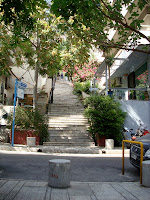Athens was never intended to be the modern capital of Greece. After the War of Independence in 1821-1830, many Greeks thought the city of Nafplio, on the east coast of the Peloponnese, ought to be the capital.

Instead, outside forces thought that Athens, the once thriving classical city, would be a more honorable capital than simply a large city with advanced infrastructure like Nafplio. Athens at the time was just a collection of small neighborhoods,
organically and sporadically placed within a small valley, and a city derived from there. Now, the neighborhoods have connected, yet remain somewhat independent bubbles of culture and style, each one having its own flair.
I've made it my goal to explore one neighborhood per day. After class is over for the day, I take my trusty map and pick a different neighborhood to go to. A few days ago I roamed the streets of Plaka, which is right near the Acropolis. There were tons of tourists and gimmicky shops, but the streets were beautiful and the sights were breathtaking. I definitely want to check out that part of town in about a month, when the tourist season dies down.
Yesterday, my roommate and I climbed to the top of Lykavittos Hill, the largest hill in Athens.

At the top, there is a theater, church and cafe. You can see every point of Athens from the top of the hill. Luckily, the smog wasn't too bad, and we could see the sea and bay.
No comments:
Post a Comment